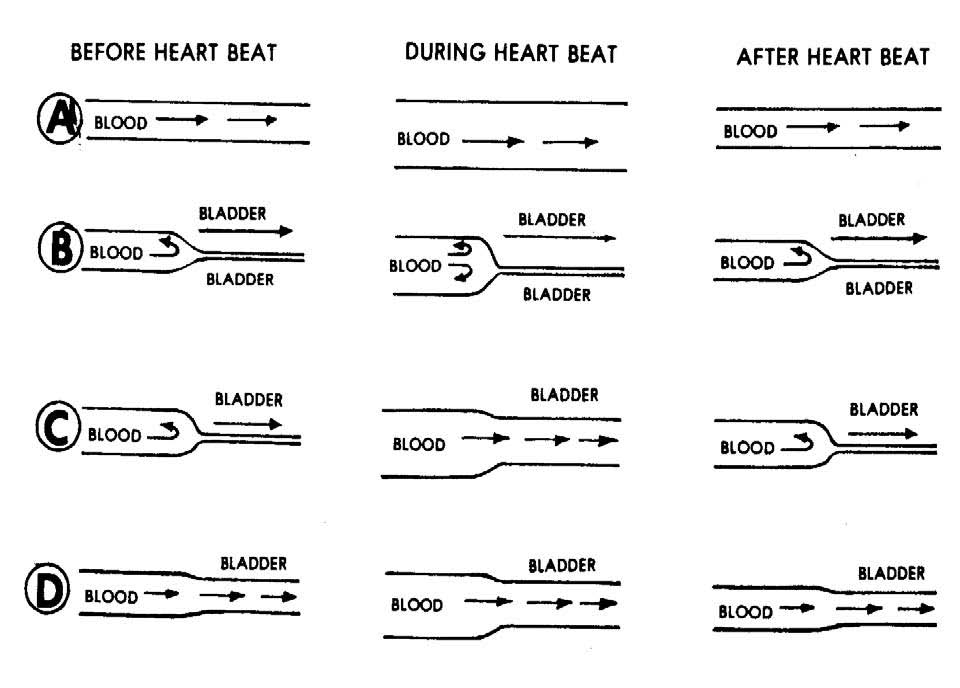 This is the Archived Desktop Edition.
This is the Archived Desktop Edition.
You should be transferred to the Newest Edition for Desktop and Mobile within 2 seconds.
Lesson 5: Blood Pressure
5-5
5-5. HOW DOES THE AIR PRESSURE INSIDE THE BLADDER PROVIDE INFORMATION ABOUT THE BLOOD PRESSURE?
Paragraph 5-1 stated that blood pressure is the force with which the blood pushes against the walls of the blood vessel. However, paragraph 5-3a(5) states that the gauge on the sphygmomanometer measures the air pressure inside the bladder!
a. Indirect Measurement. Some things cannot be measured directly without difficulty. For example, the height of a building can be measured by climbing to the top of the building, holding on to one end of a very long tape measure, and dropping the other end to a friend on the ground who reads off the height. This method may work for a building that is not very high, but is not recommended for determining the height of the Empire State Building. The height of a building, however, can be determined indirectly, such as by measuring its shadow. (Method: Put a stick in the ground so that it is straight up and down. Measure the height of the stick, the length of the stick's shadow, and the length of the building's shadow. The height of the building is equal to the length of the building's shadow times the height of the stick divided by the length of the stick's shadow.)
b. Blood Pressure Measurement. Just as the height of the building was determined by measuring something else (its shadow), the pressure of the blood at its highest (systolic) and normal (diastolic) levels can be determined by measuring the air pressure in the bladder.
(1) When the bladder is first placed around the arm and not inflated, the artery beneath the bladder functions normally (figure 5-5 A ).
(2) When the bladder is inflated, the bladder squeezes the arm. If the bladder is inflated to a pressure greater than the systolic pressure of the artery, the artery beneath the bladder will collapse (figure 5-5 B ). The artery will remain collapsed, thus shutting off blood flow below the bladder, even when there is a heartbeat. Thus, when there is no blood flow in the artery below the bladder, you know that the air pressure in the bladder is greater than the systolic blood pressure.
(3) When the bladder is inflated to a pressure that is less than the systolic pressure but greater than the diastolic pressure, blood will flow beneath the bladder only when the (blood) pressure within the artery is greater than the (air) pressure within the bladder. This occurs when the force of the heartbeat increases the pressure within the artery. Once the additional force of the heartbeat has passed (the artery returns to diastolic pressure), the artery will collapse again (figure 5-5 C ). Thus, when blood suddenly passes through the artery beneath the bladder, stops, starts again, and stops again, you know that the pressure within the bladder is less than the systolic pressure but more than the diastolic pressure.
(4) If the bladder is inflated, but the pressure within the bladder is less than the lowest level of pressure within the artery (diastolic pressure), then the bladder cannot collapse the artery. The pressure of the bladder may interfere somewhat with the blood flow, but it cannot stop the blood flow (figure 5-5 D ). Thus, when the blood continues to flow through the artery beneath the bladder without stopping, you know that the pressure within the bladder is less than the lowest (diastolic) pressure of the blood within the artery.
A Artery without the bladder--artery expands during heartbeat, returns to normal.
B Air pressure in the bladder is greater than the systolic
pressure--the artery stays collapsed.
C Air pressure in bladder is between systolic pressure and diastolic
pressure--artery collapsed except during heartbeat.
D Air pressure in bladder is less than diastolic pressure--artery does not
collapse.
Figure 5-5. Effects of an inflated bladder on an artery.

